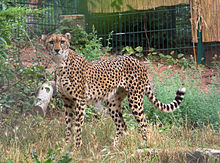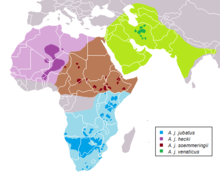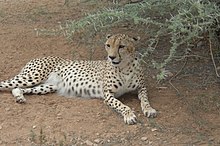Northeast African cheetah
| Northeast African cheetah | |
|---|---|

| |
| A female cheetah in Zoo Landau, Germany
| |
| Scientific classification | |
| Domain: | Eukaryota |
| Kingdom: | Animalia |
| Phylum: | Chordata |
| Class: | Mammalia |
| Order: | Carnivora |
| Suborder: | Feliformia |
| Family: | Felidae |
| Subfamily: | Felinae |
| Genus: | Acinonyx |
| Species: | A. jubatus |
| Subspecies: | A. j. soemmeringii[1]
|
| Trinomial name | |
| Acinonyx jubatus soemmeringii[1] (Fitzinger, 1855)
| |

| |
| A. j. soemmeringii range (brown) | |
| Synonyms | |
|
A. j. megabalica (Heuglin), 1863
| |
The Northeast African cheetah (Acinonyx jubatus soemmeringii) is a cheetah subspecies occurring in Northeast Africa. Contemporary records are known in South Sudan and Ethiopia, but population status in Eritrea, Djibouti, Somalia and Sudan is unknown.[2]
It was first described under the
In the 1970s, the cheetah population in Ethiopia, Sudan and Somalia was roughly estimated at 1,150 to 4,500 individuals.[5] In 2007, it was estimated that 950 individuals live inside protected areas in this region; the number of individuals living outside protected areas is unknown.[2]
This subspecies is more closely related to the
Taxonomy
Cynailurus soemmeringii was the
Following Fitzinger's description, other naturalists and zoologists described cheetahs from other parts of Northeast Africa that today are considered synonyms of A. j. soemmeringii:[1]
- Felis megabalica was proposed by Theodor von Heuglin in 1863 who described a cheetah skin purchased at the western bank of Bahr-el-Abiad. Heuglin stated that it was brought from further inland. The scientific name consists of the Greek roots mega (much) and "balios" (spotted).[7]
- Acinonyx wagneri proposed by Max Hilzheimer in 1913 was a cheetah specimen from Kordofan in Sudan. Hilzheimer named it in honour of Johann Andreas Wagner.[8]
Evolution
For a
Physical characteristics

Like its relative to the south in East Africa, the Northeast African cheetah is fairly large. Physically, it most resembles the East African cheetah; it has a densely ochraceous spotted coat with relatively thick and coarse fur in comparison to its relatives from eastern and northwestern Africa. The belly of the Northeast African cheetah is distinctly white while its breast and throat can have some black spots similar to the eastern subspecies. However, it is the darkest in fur color. This cheetah has the most widespread and separated black dorsal spots, but smaller than that of the East African cheetah's.[9][10] In contrast to the East African cheetah, the Northeast African cheetah has no spots on the hind feet, although some among the Chadian population have spotted hind legs.[4] This cheetah has distinct white patches around its eyes but the facial spotting can vary from very dense to relatively thin. The Northeast African cheetah has been seen with both white and black tipped tails, although certain cheetahs' tails are white tipped. This subspecies' tail is also notably thick.
This subspecies has the largest head size, but sometimes can get relatively smaller. However, it does not have mustache markings. The tear marks of this cheetah are highly inconsistent, but they are frequently thickest at the mouth corners, unlike those of the other four subspecies. This cheetah is the only subspecies not being reported to show a rare color variation. However, despite having the darkest fur color, certain cheetahs' fur color can be pale yellow or almost white as well. In cold climates, such as in Whipsnade Zoo, Northeast African cheetahs are the only African subspecies that can develop fluffy winter fur coats, although they are less developed than that of the Asiatic cheetah's.[11]
Distribution and habitat
| Country | Estimate |
|---|---|
| 500 | |
| 462 | |
| Total | 962 |
The Northeast African cheetah is
It inhabits wide open lands,
Ecology and behavior
Hunting and diet

The cheetahs are carnivorous and mostly feed on herbivorous animals, such as
Enemies and competitors
Like other subspecies, they are threatened and outranked by larger predators in their area, such as
Threats
The Northeast African cheetah is threatened by
The cheetah is highly threatened by the illegal pet trade from Somaliland. Cheetah cubs are sold on the black market for over $10,000 but rescuing a single cub costs more than three times that much. The majority of captive cheetah cubs is thought to die before they are exported from Africa.[15][16]
Conservation

Ethiopian Wildlife Conservation
The cheetah, together with the African wild dog, is considered emblematic of Ethiopia.[17] A conservation project for wild animals started first in 2006 after "real lack of awareness in Ethiopia about the treatment of animals".[18] The conservation goal is to ensure the increasing populations of cheetahs and other threatened wild animals in Ethiopia.[19] The Ethiopian Wildlife Conservation Authority has confiscated cheetah cubs from wildlife trade in Ethiopia, many of which have been rehomed by Born Free, at their wildlife sanctuary Ensessa Kotteh.[20]
Semi-captive breeding program
There is a reproduction programme for the cheetah at the Djibouti Cheetah Refuge in Djibouti City, which first started in 2004.[21] The Djibouti Cheetah Refuge (also known as DECAN Cheetah Refuge) was first constructed in 2002 and the initial phase was opened a year later.[22]
Rewilding project in Arabia

There is also a
Asiatic cheetahs once lived in the Arabian Peninsula until they became regionally extinct everywhere in the wild of the Middle-East in the early 1970s. The rewilding project officially started in 2008, when four captive-born Northeast African cheetahs had been reintroduced into the wild of Sir Bani Yas Island to roam free and maintain natural balance. The cheetahs are taught to breed, to survive and feed on sand and mountain gazelle on their own, then their offspring would successfully learn those instincts from their parents.[25]
Cheetahs are known to be difficult to breed and therefore, the survival rate of cheetah cubs is low both in the wild and in captivity. However, the project has been successful so far. In April 2010, the first four cheetah cubs had been born on the island from a successfully rewilded Northeast African cheetah mother named 'Safira'. According to conservation team, the cubs' mother had done an impressive job in taking care of her children. The cubs are recognized to be the first wild-born cheetahs in
The Al-Wabra Wildlife Preservation (AWWP) from Qatar, Al-Dhaid Wildlife Centre from Sharjah, the Nakelee Wildlife Centre and the Wadi Al-Safa Wildlife Centre from Dubai are also part of the international breeding programme to help save the rare cheetah population which are breeding in captivity. The breeding programmes of the Middle-East are aiming to release the cheetah into the wild of Africa. There are currently 23 adults and 7 cubs in Wadi Al-Safa.[30][31]
In captivity


There are breeding programs from
Cheetahs are known to be difficult to breed, especially in captivity. The Northeast African cheetah has been breeding in captivity for many years in Arabian zoos, such as Al Ain Zoo and Arabian wildlife centers from Qatar, Sharjah and Dubai. The cheetahs breeding in European zoos are found at
The first captive breeding projects for the Northeast African cheetah started in Sheikh Butti Al-Maktoum's Wildlife Centre in early 1994, then followed by the Sharjah's Arabian Breeding Centre in late 2002 and Wadi Al Safa Wildlife Centre in 2003, until captive-bred Northeast African cheetahs from the Middle East were sent to two European zoos, Zoo Landau and Beekse Bergen Safari Park. La Palmyre Zoo would receive the cheetahs 6 months later as well.[citation needed]
Tamed cheetahs


Both continents of Africa and Asia had 100,000 cheetahs in the 19th century. Cheetahs were once numerous in north, central and in the
This was the Egyptian tradition that was later passed on to the ancient
See also
References
- ^ OCLC 62265494.
- ^ a b c d e Durant, S.; Mitchell, N.; Ipavec, A. & Groom, R. (2015). "Acinonyx jubatus". IUCN Red List of Threatened Species. 2015: e.T219A50649567.
- ^ a b Fitzinger, L. (1855). "Bericht an die kaiserliche Akademie der Wissenchaften über die von dem Herrn Consultatsverweser Dr. Theodor v. Heuglin für die kaiserliche Menagerie zu Schönbrunn mitgebrachten lebenden Thiere". Sitzungsberichte der Kaiserlichen Akademie der Wissenschaften. Mathematisch-Naturwissenschaftliche Classe. 17: 242–253.
- ^ a b Harper, Francis, (1886-1972) Sudan Cheetah (Acinonyx jubatus soemmeringii) Extinct and vanishing mammals of the Old World: 280.
- ISBN 9780226094342.
- ^ PMID 21214655.
- ^ Heuglin, T. von (1863). "Über katzenartige Raubthiere des obern Nilgebietes". Verhandlungen der Kaiserlichen Leopoldino-Carolinischen Deutschen Akademie der Naturforscher. 4 (3): 22–23.
- ^ Hilzheimer, M. (1913). "Über neue Geparden nebst Bemerkungen über die Nomenklatur dieser Tiere". Sitzungsberichte der Gesellschaft Naturforschender Freunde zu Berlin (5): 283–292.
- ^ Heller, E., Roosevelt, T. (1914) Soudan Cheetah (Acinonyx jubatus soemmeringii) Life-histories of African game animals (1914): 248.
- ^ Edmund Heller (1913). "New Races of Carnivores and Baboons from Equatorial Africa and Abyssinia" (PDF). Smithsonian Miscellaneous Collections. Retrieved 30 December 2016.
{{cite journal}}: Cite journal requires|journal=(help) - ^ "Big Picture: Bedfordshire's Easter cheetahs". BBC News. 29 March 2013. Retrieved 4 June 2015.
- ^ IUCN SSC (2007). Regional conservation strategy for the cheetah and African wild dog in Eastern Africa. Gland, Switzerland: IUCN Species Survival Commission.
- ^ Denis-Hoot, 198.
- .
- ^ DOTWnews (17 July 2014). "Cheetahs traded as 'luxury pets' in Middle East at risk of extinction". Destinations Of The World News. Retrieved 23 July 2015.
- ^ "Three cheetah cubs to enjoy new life after rescue from illegal pet trade". Wildlife Extra News. Retrieved 23 July 2015.
- ^ "National action plan for the conservation of cheetah and African wild dog in Ethiopia" (PDF). 2012. Retrieved 23 July 2015.
{{cite journal}}: Cite journal requires|journal=(help) - ^ a b Emily Wax (9 January 2006). "Cheetahs Find Rare Refuge Amid Poverty Of Ethiopia". The Washington Post. Retrieved 23 July 2015.
- ^ "Ethiopia's Cheetahs, Wild Dogs, and Lions Get National Action Plans". Wildlife Conservation Society. 19 April 2012. Retrieved 23 July 2015.
- ^ "Wildlife Conservation". Born Free. Born Free Foundation. Retrieved 25 June 2024.
- ^ "Endangered cheetah gives birth to three cubs in Djibouti". terradaily.com. 22 June 2006. Retrieved 5 June 2015.
- ^ "DECAN Cheetah Reserve". DoDLive.mil. 1 December 2011. Retrieved 5 June 2015.
- ^ Rayeesa Absal (6 April 2010). "Birth of four cubs signals return of cheetah to UAE". GulfNews.com. Retrieved 4 February 2015.
- ^ Binsal Abdul Kader (1 January 2011). "Rewilding of Cheetahs a big success in Sir Baniyas Island". GulfNews.com. Retrieved 4 February 2015.
- ^ John Henzell (22 February 2010). "Survival instinct kicks in for Sir Bani Yas cheetahs". TheNational.ae. Retrieved 15 February 2015.
- ^ "First wild born cheetah for 40 years in Arabia". WildlifeExtra.com. Retrieved 15 February 2015.
- ^ "Sir Bani Yas Island nature reserve is an 'Arabian Ark'". News.com.au. 13 February 2015. Retrieved 15 February 2015.
- ^ "The Northern Cheetah finds a new home on Sir Bani Yas Island". SirBaniYasIsland.com. 15 April 2010. Retrieved 15 February 2015.
- ^ Andy Sambidge (5 April 2010). "Baby cheetahs born on Abu Dhabi island". HotelierMiddleEast.com. Retrieved 6 April 2015.
- ^ "Al Wabra Wildlife Preservation (AWWP)" (PDF). Retrieved 14 March 2015.
- ^ Colin Simpson (29 July 2012). "Wildlife centres in UAE toast births of cheetahs". TheNational.ae. Retrieved 14 March 2015.
- ^ "Captive breeding of North African cheetah, Acinonyx jubatus soemmeringii" (PDF). September 2006. Retrieved 4 February 2015.
- ^ "FOTA CELEBRATES BIRTH OF 1st BABY CHEETAH IN 5 YEARS". FotaWildlife.ie. 25 October 2013. Retrieved 24 May 2015.
